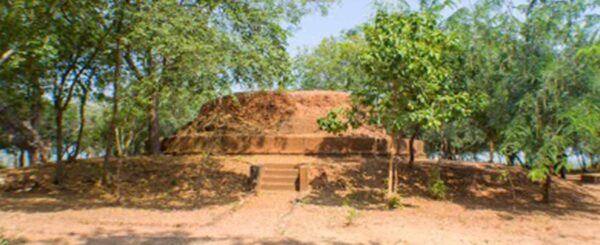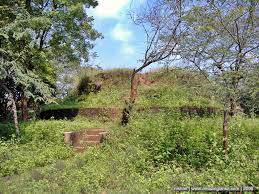“Damila Maha Seya” – incomplete archaeological site
By Arundathie Abeysinghe

 Located in the ancient city complex of *Polonnaruwa covering an area of approximately 1.6 hectares (four acres), “Damila Maha Seya” also known as “Damila Thupa” or “Demala Maha Seya” is an incomplete stupa constructed during the reign of King Parakramabahu I (1153-1186) utilizing labor of Tamil prisoners brought from India when he attacked the *Chola Kingdom of South India. Due to some unknown reason, the King had been unable to complete the Stupa.
Located in the ancient city complex of *Polonnaruwa covering an area of approximately 1.6 hectares (four acres), “Damila Maha Seya” also known as “Damila Thupa” or “Demala Maha Seya” is an incomplete stupa constructed during the reign of King Parakramabahu I (1153-1186) utilizing labor of Tamil prisoners brought from India when he attacked the *Chola Kingdom of South India. Due to some unknown reason, the King had been unable to complete the Stupa.
This stupa is similar to *Kota Vehera in Dedigama and *Yudaganawa Stupa (considered as the location of King Parakramabahu’s mother’s cremation).
This gigantic incomplete stupa is located between *Gal Viharaya and *Thivanka Pilimage and is at present, a protected archaeological site.
Scholars are of the view that, although, King Parakramabahu I has planned this 12th century stupa of 186 meters (570 feet) height as the world’s largest Buddhist monument, even with enforced assistance of Tamil prisoners, it could not be completed. The circumference of the Stupa is approximately 650 meters and it is still undergoing excavations. It is gradually emerging from the forested hill.
Many archaeologists are of the view that King Parakramabahu wanted to see this monument from India and the size has been planned accordingly.
According to scholars, this stupa is similar to a small hill enveloping a large existing quartzite rock.
Except a section of the outer ring (Pesa Walalu) approximately 10 meters in length, there is no indication of a stupa at the location. Beyond these rings, there is a footpath leading to the summit of the stupa.
According to *Mahawamsa, King Parakramabahu attacked the *Pandya Kingdom and brought back Tamil prisoners of war. He stated that these prisoners should be employed to reconstruct all stupas that were destroyed during their past invasions and he also reconstructed the dilapidated *Ruwanweli Seya in Anuradhapura.
During the early 1900’s, a different structure was mistakenly identified as “Demala Maha Seya” and the majority of information regarding this stupa during that era referred to this other structure. Yet, the archaeological report of 1905 has identified this error and states that “Demala Maha Seya” as described in the Mahawamsa was known as “Unagala Vehera” during that time.
Some scholars are of the view that the Stupa was originally known as “Damahal” (meaning double storey) as it was constructed in two levels and later became “Demala”.
 Since 2017, restoration of the stupa has commenced, although at a slow pace.
Since 2017, restoration of the stupa has commenced, although at a slow pace.
This stupa is rarely visited by tourists as it is not a well-known site and also due to the hazardous condition of the road leading to it. It is necessary to travel in a 4x drive vehicle to reach the stupa. Thereafter, it is necessary to walk approximately 50 meters to reach it.
There is another smaller stupa in the center on the incomplete hemispherical structure which would have been constructed later. It is also possible to climb to the smaller stupa and view the surroundings, a breathtaking site…
Image courtesy – amazinglanka.com & infolanka.lk
- Anuradhapura – A major city in Sri Lanka (former Ceylon), the capital of Anuradhapura District was one of the ancient capitals of Sri Lanka famous for its well-preserved ruins of Sri Lankan civilization. Founded in the 4th century, Anuradhapura was the capital of Sri Lanka until the beginning of the 11th century. Anuradhapura is considered sacred to Buddhists and there are monasteries, stupas within an area of 40 square kilometers. Anuradhapura was declared as the “Sacred City of Anuradhapura” and a World Heritage Site by UNESCO in 1982.
- Chola conquest – This was a military invasion of the Anuradhapura Kingdom by the Chola Empire of Southern India, one of the longest ruling dynasties in world history. Initially, the Anuradhapura Kingdom was invaded in 993 AD and absorbed into the Chola Empire of Southern India.
- Gal Viharaya – Known originally as “Uttararama”, Gal Viharaya is a rock temple of the Buddha situated in the ancient city of Polonnaruwa constructed in the 12th century during the era of King Parakramabahu I.
- Jethawanarama Complex – Located in the ruins of Jetawana Monastery in Anuradhapura, towards east of *Ruwanveliseya Stupa, the Complex has extensive ruins of excavated stone foundations immaculately laid out amongst well-maintained lawns and demarcated pathways covering an area of approximately three hectares (eight acres).
- King Parakramabahu I (1153 to 1186) – Also known as “Parakramabahu the Great” was the king of the Kingdom of Polonnaruwa. During his reign, he oversaw the expansion as well as remodeling of the Kingdom, reformed Buddhist practices, constructed extensive irrigation systems, reorganized the country’s army, encouraged the arts and also undertook military campaigns in Southern India and Myanmar. During King Parakramabahu’s reign in 1173, an invasion commenced against the dynasties of South India and the *Pandyan Kingdom was first captured which later advanced into *Chola region.
- Mahawamsa — “Great Chronicle” or “Great Dynasty” in Sinhala is the most significant work of Sri Lankan origin written in Pali Language. This Chronicle describes life and times of Sri Lankans from the arrival of Vijaya in 43 BC to the reign of King Mahasena from sixth century BC to fourth century AD. Culawamsa (lesser chronicle) covers the period from fourth century AD to British takeover of Sri Lanka in 1815. Mahawamsa consists of three parts covering a historical record of over two millennia. It is considered as the world’s longest unbroken historical record.
- Pandyan Kingdom – One of the three ancient Tamil Kingdoms (Chola and Chera being the other two) also referred to as the “Pandyas of Madurai” was an ancient dynasty of South India from pre-historic times until the end of the 15th century. Pandyas entered their golden age under Jatavarman Sundara Pandyan (c. 1251) who expanded their empire into Telugu country and invaded Sri Lanka to conquer the northern regions. Pandyas had extensive trade links and excelled in trade. They also controlled pearl fisheries along the South Indian coast between Sri Lanka and India.
- Polonnaruwa – The Kingdom of Polonnaruwa or the ancient city of Polonnaruwa (known as Pulastipura) was the second capital of Sri Lanka for three centuries from 11th to 13th centuries. After the *Chola conquest of Anuradhapura Kingdom, the center of administration was shifted to Polonnaruwa until 1232. Polonnaruwa has been declared a World Heritage Site by UNESCO.
- Ruwanweliseya – Also known as the “Mahathupa” is a stupa (a hemispherical structure containing sacred relics) in Anuradhapura, the largest collection of the Buddha’s relics are enshrined in it. Constructed by King Dutugemunu (137BC to 119BC). in the 2nd century BC, after he united Sri Lanka under one kingdom. King Dutugemunu was of the view that the stupa could be completed during his lifetime, yet he fell ill and was unable to see the completed stupa. Hence, to fulfill his elder brother’s wish, Prince Saddhatissa (who reigned as King Saddhatissa 137 BC to 119 BC) ordered the craftsmen to cover the incomplete sections of the stupa in white cloth and to make it appear as if it has been completed. Hence, King Dutugemunu passed away at the location assuming that Ruwanweliseya was complete. King Saddhatissa completed the construction of the stupa during his reign.
- Thivanka Pilimage (Thivanka Image House) – Constructed by King Parakramabahu I (1153-1186) as part of the Jethawanarama Complex, it is a vaulted type Image House (gedige) well-known for its paintings depicted on the inner walls. The Buddha Statue at Thivanka Pilimage is approximately 8 meters in height, yet, at present, the section of the Statue above the head has been destroyed. Hence, at present the statue is 6.6 meters tall. The walls and the roof of this Image House have been constructed out of brick similar to Image Houses in Polonnaruwa.
“Kota Vehera” – commemoration of a royal birth – By Arundathie Abeysinghe
https://www.elanka.com.au/kota-vehera-commemoration-of-a-royal-birth-by-arundathie-abeysinghe/
Yudaganawa – largest stupa in the south and east of Sri Lanka By Arundathie Abeysinghe







